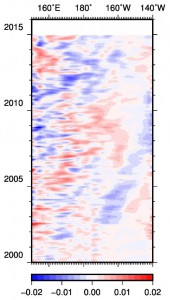Shinya Koketsu
An application of tracer inverse methods on neutral density surfaces in the North Pacific, and the impacts of mixing on the decadal property changes.
Research Summary
Mixing in the ocean is one of the important elements to elucidate the circulation of heat, mass, and various dissolved materials. Recently, many observational and numerical researches reveal that the strong mixing (especially small-scale turbulent mixing) occurs intermittently and locally. Thus, it is difficult to make the basin-scale mapping of mixing strengths based on direct observations. On the other hand, small long-term salinity (temperature) changes on the neutral surfaces can be clearly detected based on observations (ex. Fig. 1), which can be strongly affected by the spatial distribution and the temporal variability of mixing processes. To evaluate the changes on the isopycnal surfaces more precisely, in this study, I plan to estimate the mixing coefficient maps that are consistent with the observational tracer distributions based on the tracer inverse methods, that are suggested in the previous studies, and investigate impacts of the mixing distributions on the long-term changes in the ocean. I expect to contribute the purpose of the OMIX project by comparing results from the regional observation efforts near the western boundaries as well as large-scale circulation patterns and the variabilities revealed by the reanalysis and the advanced numerical models.

Fig. 1: Salinity anomaly propagations from west to east along about 42°N on 27.4σ surface in the North Pacific. Horizontal and vertical axises are longitudes and years.
Principal Investigator:
Shinya Kouketsu
Japan agency for Marine-Earth Science and Technology, Senior Scientist ,Physical Oceanograhy


